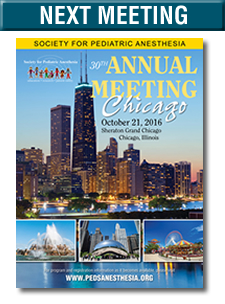Journal review
Journal Review: Anesthesiology
By Elizabeth S. Yun, MD
University of Wisconsin School of Medicine
Madison, WI
For the first half of 2016, the journal Anesthesiology published several articles featuring pediatric anesthesia topics. This review briefly summarizes these articles and these can be found on website http://anesthesiology.pubs.asahq.org/journal.aspx.
The January 2016 issue featured the article Major Adverse Events and Relationship to Nil per Os Status in Pediatric Sedation/Anesthesia Outside the Operating Room by Beach M et al. The authors used the Pediatric Sedation Research Consortium database to evaluate a possible link between NPO status and the incidence of major adverse events, defined as aspiration, death, cardiac event, unplanned hospital admission. From a total of 139,142 cases from the database the authors found 0 deaths, 10 aspirations and 75 major complications.
The NPO status was known for 107,947 patients with 23 percent of this group not being NPO. Their findings showed that aspiration occurred in 0.97 events per 10,000 in the NPO group and 0.79 events in 10,000 events in the non NPO group. For other adverse events, the NPO group had 5.57 events per 10,000 and the non NPO group had 5.91 events per 10,000. While other variables such as young age, emergency status and ASA status did have a positive correlation with the incidence of a major adverse event, these factors did not change the lack of association between NPO status and aspirations. Because of the limitations of the data and the very low incidence of aspiration in the database, the authors felt that the relationship between NPO status and patient injury remains uncertain.
The April 2016 issue had several articles with a pediatric focus. The first paper, Effect of Inhalational Anesthetics and Postive-pressure ventilation on Ultrasound Assessment of the Great Vessels: A Prospective Study at a Children’s Hospital by Lin EE et al. discussed the effects of the size of the IVC with inhaled anesthesia and positive pressure ventilation as measured by ultrasound. They noted that bedside ultrasound of the IVC is now being utilized as a tool for assessing and monitoring fluid status in children since IVC size varies with changes in blood volume and thoracic pressure.
Because the IVC changes with age and size of the child, the ratio of IVC to the aorta (IVC/Ao) is used to assess intravascular fluid status in children. For adults, changes in the IVC due to respiratory variation (IVC/RV) are an indicator of fluid status. In this study the authors performed a prospective observational study on 24 healthy children 1-12 years having elective surgery. The children had ultrasound evaluations of the IVC and aorta at 5 points: awake, spontaneous ventilation with sevoflurane, and intubated with 3 different peak inspiratory and positive end expiratory pressures. A blinded investigator then calculated the IVC/Ao and IVC/RV from recorded videos.
The authors found that the inhaled anesthesia decreased the IVC/Ao but not the IVC/RV. The initiation of positive pressure ventilation (PPV) led to an increase in IVC/Ao and a decrease in IVC/RV and these values did not change with increased PPV. Based on this work, the authors suggest that clinicians should be aware of these expected changes of the IVC and that establishing IVC parameters will lead to future research in using these measurements for evaluating volume status in children.
The article, Differential Suppression of Spontaneous and Noxious-evoked Somatosensory Cortical Activity by Isoflurane in the Neonatal Rat by Chang P et al, noted that there are few studies looking at the effect of a noxious surgical input to the infant brain. To look at this effect the authors tested the effect of increasing isoflurane concentration on spontaneous and evoked nociceptive activity in the somatosensory cortex of rats grouped by ages of post natal day 7,14, 21 and 30. Each age group was initially anesthetized with 4% isoflurane and then maintained at 1.5% for surgical preparation and electrode insertion. The inspired isoflurane concentration was then incrementally increased from 1.5% to 5% and the responses recorded. In the second experiment responses before, during and after plantar hind paw incision were compared in rats from the postnatal day 7 and 30 groups.
The authors found that the P7 group demonstrated increased resistance of noxious evoked potentials compared to the older group during the paw incision even at higher isoflurane concentrations. This resistance appeared to be age related since the noxious evoked potential response decreased drastically with the increased isoflurane concentration in rats in the older age group. These rats did experience increased response to the hind paw incision but this response was suppressed at the higher isoflurane levels. The authors demonstrated that in in rats at day 7 (an age that translates to a 1-2 month old) even though spontaneous activity is suppressed by isoflurane in the neonatal brain, isoflurane has less effect on cortical activity due to a peripheral noxious stimulus.
This article was accompanied by an editorial More Than Anyone Else Preemies Need Good Analgesia by Laszlo Vutskits MD, PhD. The author discussed the importance of the observations of this paper in showing that a general anesthetic at high concentrations may not be enough to blunt the immature brain’s response to a noxious stimulus. The author stated that this work is an important step in understanding the impact of a surgical procedure on the immature brain.





